Exploring Tilling Attachments for Riding Mowers
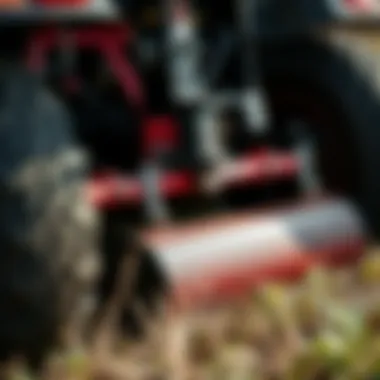
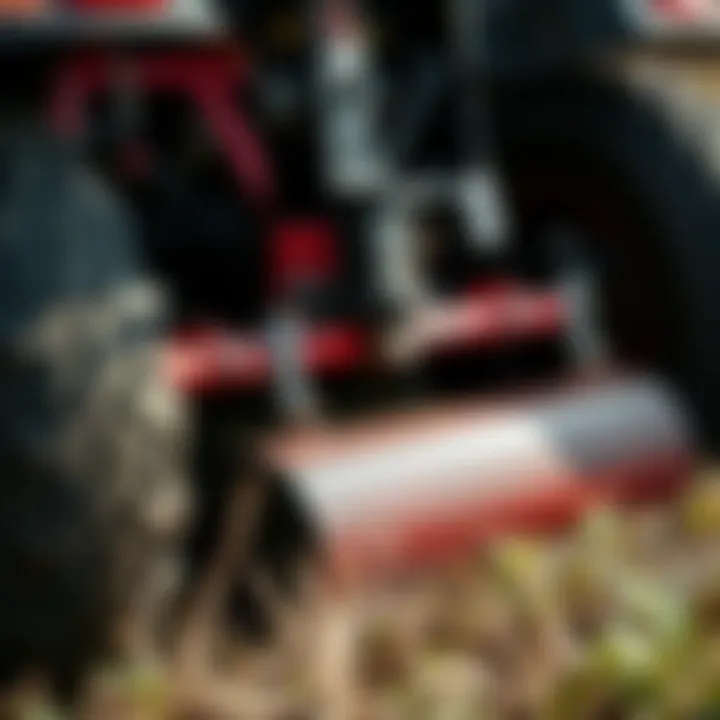
Intro
As gardening transforms from a mere hobby into a significant contributor to sustainable living, the tools involved in soil preparation can make all the difference. Among these, tilling attachments for riding mowers stand out as a particularly versatile option. These attachments take a standard mower and turn it into a dynamic tool for soil management, giving gardeners and farmers the potential to improve their plots significantly. This article will explore why these attachments matter, the various types available, and how they revolutionize gardening practices today.
Topic Overview
Definition and Importance
Tilling attachments for riding mowers are accessories designed to cultivate the soil effectively and efficiently. By breaking up compacted earth, aerating the soil, and mixing in organic matter, they play a fundamental role in promoting healthy plant growth. Improved soil structure leads to better water retention and nutrient availability, which are crucial for optimum plant health.
Brief History and Evolution
The roots of tilling can be traced back thousands of years, with ancient civilizations employing rudimentary tools to till the land for crops. Over the centuries, the technology has evolved from simple hand tools to sophisticated machinery. Riding mowers equipped with tilling attachments emerged as a response to increasing needs for efficiency. Instead of traditional methods that can be labor-intensive, the modern farmer or gardener can leverage these attachments to cover more ground with minimal strain. In the 1980s, manufacturers began designing attachments that were not only effective but also compatible with existing mower models. This evolution speaks to both innovation and practicality in sustainable agriculture.
Key Techniques and Innovations
Sustainable Farming Practices
These tilling attachments align perfectly with sustainable farming practices. They allow gardeners to integrate principles like crop rotation and cover cropping with ease, ultimately fostering healthier ecosystems right in one’s backyard. By reducing the reliance on chemicals and improving soil structure, these practices not only benefit individual plots but contribute to the larger environmental picture as well.
Advanced Agronomic Technologies
Today's tilling attachments harness materials and designs influenced by advancements in technology. For example, some models utilize a system of variable depth control, allowing precise adjustment based on soil type or desired casting depth. This technology ensures optimal soil health while safeguarding against over-tilling, thereby preventing erosion and nutrient loss. Furthermore, features such as enhanced durability and compatibility with various mower brands represent a significant leap in innovation.
Practical Applications
Step-by-Step Guides
To leverage the benefits of tilling attachments effectively, one must know how to use them properly. Here’s a simple step-by-step guide:
- Choose the Right Attachment: Make sure it’s compatible with your riding mower.
- Prepare the Mower: Ensure your riding mower is in good working order, including fuel and blade checks.
- Set the Depth: Adjust the tilling depth according to your needs.
- Begin Tilling: Start at one end of your plot and work systematically, overlapping slightly to ensure thorough coverage.
- Post-Till Care: After tilling, assess the soil condition. Reseed or amend the soil as necessary.
Case Studies or Real-World Examples
Numerous farmers have embraced tilling attachments and savored the rich harvests yielded from their endeavors. For instance, a community garden in Lansing, Michigan, adopted tilling attachments for their collective garden beds— they quickly noticed an uptick in productivity and soil quality. By cultivating the soil just right, they managed to grow organic produce that amazed both chefs and gardeners alike. The success stories echo across rural areas, featuring how small farm owners transitioned from traditional plowing to utilizing riding mowers with tilling attachments, ultimately saving precious labor hours while enhancing their soil health dramatically.
"Investing in the right tools can change not just how you garden, but how you feel about your impact on the earth. That's the real win here."
Prelims to Tilling Attachments
Tilling attachments for riding mowers represent a crucial intersection between machinery and agricultural practice. With an enhancement in efficiency and soil handling capabilities, these attachments cater to the modern gardener and farmer alike. Understanding their role is essential for any individual or organization striving for soil health and optimal output in their gardening or farming endeavors.
Tilling, at its core, is about preparing the earth. However, it goes beyond mere turnover of soil; it creates a suitable environment for seed germination, aeration, and nutrient absorption. Tilling attachments for riding mowers turn what could be labor-intensive work into a task that is manageable and relatively straightforward. It's all about getting your hands dirty, yet remaining efficient and smart in your approach.
Overview of Tilling in Agriculture
Tilling has a long history in agriculture, functioning as a foundational practice for soil preparation. Essentially, it's the mechanical breaking up of the soil to facilitate planting. But it's not just a matter of putting the plow to the earth. Different tilling practices have evolved that reflect the type of crop being planted, the characteristics of the soil, and even environmental considerations.
Farmers and garden enthusiasts often utilize various tilling methods:
- Conventional Tilling: This involves turning over the soil completely, which helps to aerate and mix in nutrients but can also lead to soil erosion and degradation over time.
- No-Till Farming: As the name suggests, this method avoids disturbing the soil structure, promoting natural habitats for beneficial microbes.
- Reduced Tillage: A compromise that offers some soil disturbance but maintains more soil health compared to conventional methods.
Each of these methods illustrate the versatility and crucial importance of tilling in agricultural practices, directly influencing crop yield and sustainability.
Importance of Tilling in Soil Preparation
When it comes to cultivation, soil is not just a waiting area for plants; it’s an active ecosystem. The importance of tilling in soil preparation lies in various factors. For starters, it enhances soil aeration. Adequate air circulation allows roots to breathe, which is fundamental for healthy growth. Furthermore, tilling affects water retention, as well-prepared soil can absorb moisture better, making it highly effective during dry spells.
Another notable aspect is the incorporation of organic matter. As farmers mix in compost or other nutrients during tilling, they facilitate the recycling of vital elements back into the earth. This results in healthier soil and better equipped plants.
"Tilling not only rejuvenates the soil but also rekindles the bidirectional relationship between earth and vegetation."
In summary, tilling creates an environment ripe for future plant growth, driving home the importance of selecting the right tilling attachment for your riding mower. It’s not merely about the tools you have at your disposal; it’s about understanding how to wield them effectively to carve out the best possible growing conditions.
Understanding Tilling Attachments for Riding Mowers
When delving into the world of gardening and land management, one might wonder about the nitty-gritty of tilling attachments. These pieces of equipment are designed primarily for riding mowers, transforming them into powerful tools for soil preparation. A proper understanding of these attachments not only elevates one's gardening game but significantly impacts the effectiveness of soil cultivation.
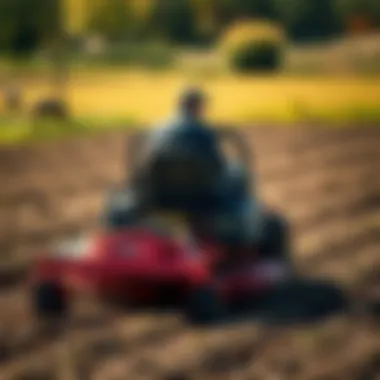
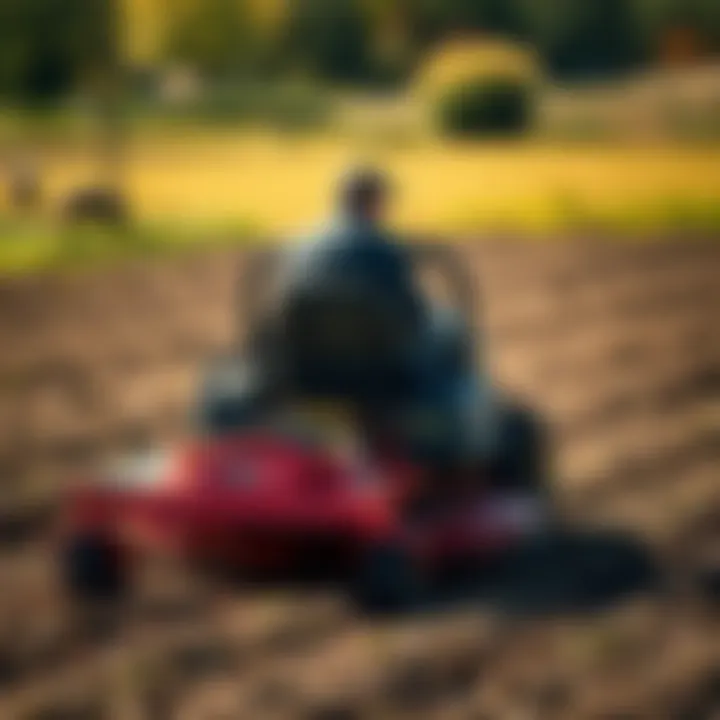
What are Tilling Attachments?
Tilling attachments are specialized tools that can be attached to riding mowers, allowing them to break up, mix, and aerate soil. They play a crucial role in preparing land for planting crops, flowers, and other vegetation. Essentially, these attachments enhance the capabilities of riding mowers, making them versatile assets in any garden or agricultural setup.
Tilling attachments come in various forms, each designed to serve specific functions or deal with different types of soil. They make the process of tilling faster and often more efficient than traditional manual methods. Without these attachments, larger plots of land would require an extensive amount of labor and time to prepare for planting.
Types of Tilling Attachments
There’s a variety of tilling attachments, each bringing unique qualities to the table. Three common types include:
Rotary Tiller Attachments
Rotary tiller attachments are a popular choice among gardening enthusiasts. They work by rotating blades that cut into the soil, turning it to create a loose, aerated texture ideal for planting. One key characteristic is their ability to handle tough soil. They can tackle compacted earth, making them suitable for a range of gardening situations.
What sets rotary tiller attachments apart is their capability to churn deeply into the ground, mixing organic matter effectively. This feature promotes healthier soil and, consequently, healthier plants. However, their power and aggressive nature can sometimes lead to over-tilling, which may disturb beneficial organisms in the soil.
Disc Tiller Attachments
Next up are disc tiller attachments, which utilize rotating discs to cut through soil layers. A notable aspect: their design allows for effective mixing of soil and compost. This quality makes them particularly useful in preparing garden beds with a blend of nutrients.
The discs can slice through weeds too, offering a two-in-one solution for soil preparation. Though beneficial, one should handle these attachments carefully, as they may be less effective in extremely rocky soils where they can encounter obstructions.
Chain Tiller Attachments
Lastly, chain tiller attachments are a less conventional but valuable option. They use a chain mechanism that beats through the soil, breaking it up with a shaking motion. This unique method provides a gentle approach to tilling, perfect for delicate soil structures or sustainable gardening practices.
A significant advantage is their ability to work quickly without excessively disturbing the earth. However, depending on soil conditions, they may not penetrate as deeply as rotary or disc tillers, which could limit their effectiveness in certain types of projects.
"The right tilling attachment can make all the difference in achieving optimal soil health and plant growth."
In summary, understanding the distinctions among these types aids garden enthusiasts and farmers in selecting the most suitable attachment for their specific needs. It’s clear that knowledge in this area not only improves efficiency but also fosters better soil management practices.
Key Features of Tilling Attachments
When it comes to using tilling attachments with riding mowers, understanding their key features is paramount. These characteristics not only determine how effectively the implements can perform, but they also influence their adaptability to various soil types and gardening practices. Properly chosen tilling attachments can make the difference between a thriving garden and one that struggles to produce.
Size and Compatibility
The size of a tilling attachment is a crucial aspect that must be carefully assessed before making a purchase or a connection to a riding mower. Not every attachment fits with every mower model, and it's essential to ensure compatibility. Generally, the tilling width varies, with some attachments spanning a few feet while others can cover broader areas. This difference can affect how quickly you can prepare your garden.
When selecting an appropriate size, consider the size of your garden and the power of your riding mower. Lighter mowers may not handle larger or more robust attachments well, risking damage or inefficiency. Make sure to consult the manufacturer's guidelines for your specific mower model.
"A well-fitted attachment can make tilling smoother and more effective, ensuring uniform soil preparation."
Motor Power and RPM
Another significant feature is the motor power of the riding mower and the associated RPM (revolutions per minute) that the tilling attachment can generate. A more powerful motor can drive the tiller through tough soil, which is especially important if you're dealing with rocky or heavily compacted earth. The tiller's design should ideally match the mower's capacity—anything too demanding can lead to mechanical issues.
For many homeowners, a moderate RPM is adequate for general gardening tasks, but for those engaged in professional or commercial agriculture, higher RPMs are often required to effectively break soil. It's beneficial to experiment with different speeds to find the most effective rate for the specific soil conditions you face.
Blade Configuration and Material
The blade configuration plays an intricate role in the effectiveness of a tilling attachment. Attachments may feature a variety of blade shapes, including straight, curved, or spiral designs, each serving a unique purpose. For instance, curved blades often penetrate soil easier, while spiral blades may be better suited for turning and mixing.
The material used in the blades also matters considerably. Steel blades tend to provide durability and longevity, especially in rough terrain, whereas lighter materials may lead to easier maneuverability but might wear out more quickly.
Understanding how these features work together can significantly enhance your tilling efforts, helping ensure that the soil is not just stirred, but is also aerated properly to promote healthy plant growth.
In summary, these key features are more than just specifications—they're foundational elements that determine how well a tilling attachment will perform in your gardening endeavor. Assessing size, motor power, and blade configuration will prepare you for a successful tilling project.
Advantages of Using Tilling Attachments
Tilling attachments for riding mowers come with a host of advantages that can fundamentally alter how you approach soil preparation. These tools not only save you time and effort but also enhance the health of your soil, leading to better plant growth. In the realm of agriculture, where efficiency and productivity are key, understanding the benefits of these attachments can make a significant difference in both small gardens and large farming operations.
Efficiency in Soil Preparation
When it comes to soil preparation, efficiency is of the essence. Tilling attachments transform the back-breaking labor of turning the soil into a seamless process. Instead of relying solely on physical labor, these attachments integrate with your riding mower to create a powerful tool for effective soil management.
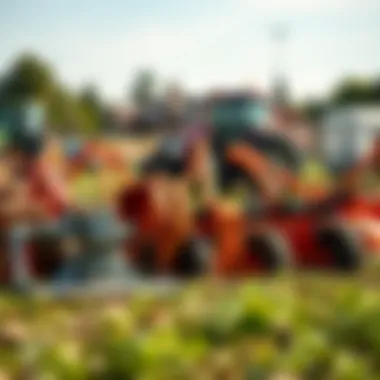
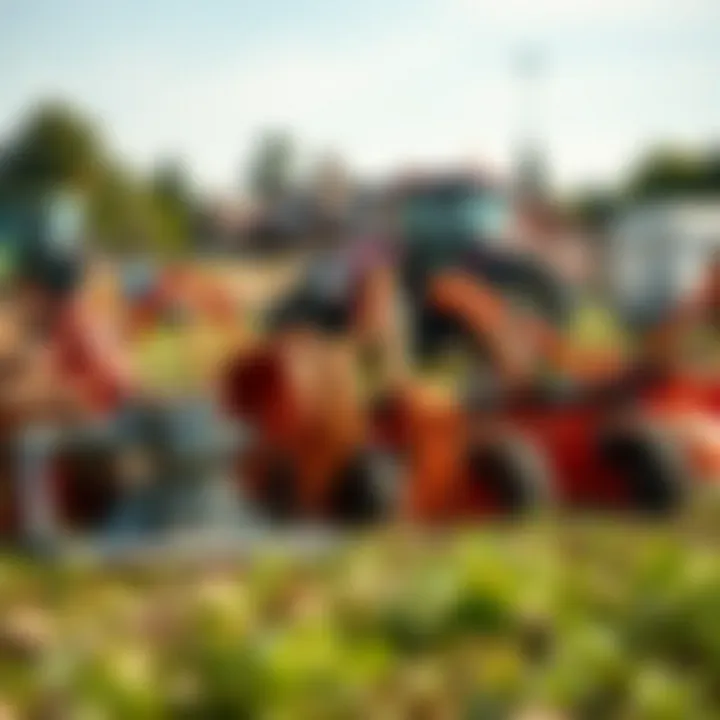
Using a tilling attachment allows you to cover large expanses of land in a fraction of the time compared to traditional methods. For example, where manual tilling might take hours of grueling work, a riding mower equipped with an efficient rotary tiller can complete the same task in a significantly shorter period.
This efficiency is not just about speed; it also means that the soil can be prepared to a better consistency. The fine, aerated soil that results from effective tilling provides an ideal environment for seeds to germinate and grow.
Time Savings Compared to Manual Tilling
In today’s fast-paced world, time is a valuable commodity, especially for those engaged in farming or gardening. This is where tilling attachments shine. Imagine spending a weekend breaking your back with a shovel while your neighbors are enjoying their afternoon coffee; it doesn’t seem fair, does it? Tilling attachments allow for quicker soil turnover, which translates to more time to focus on other essential tasks such as planting or caring for existing crops.
- Manual tilling is labor-intensive and can often result in tired muscles and sore backs.
- A tilling attachment allows for smooth operation, using the mower’s power to ease the strain.
- You can adjust how deep you till based on your needs, ensuring optimal soil structure without wasting energy.
This time saved is crucial during planting seasons when every moment counts.
Improved Soil Health and Plant Growth
One of the most compelling arguments for integrating tilling attachments into your gardening or farming routine lies in their impact on soil health and subsequently, plant growth. Proper tilling loosens compacted soil, allowing air and moisture to penetrate more deeply. This is fundamental for root development.
Moreover, tilling can help break down debris, mix organic matter into the soil, and promote microbial activity - all vital to sustaining productive soil. According to experts, the better the soil quality, the healthier the plants that grow in it. A well-tended garden not only looks good; it produces better yields too.
“Healthy soil is the cornerstone of healthy plants.”
Utilizing tilling attachments ensures that you not only prepare your soil but also fortify it as an ecologically balanced environment.
Epilogue
In summary, the advantages of using tilling attachments for riding mowers resonate throughout the gardening and farming communities. The efficiency in soil preparation, time savings when compared to manual methods, and the potential for improved soil health all come together to enhance the gardening experience significantly. Making the switch to using these attachments could be a game changer for agricultural enthusiasts and professionals alike.
For more information about soil and gardening practices, consider visiting resources like Wikipedia or Britannica.
Considerations When Selecting a Tilling Attachment
Selecting the right tilling attachment for your riding mower is a task that requires careful consideration. It’s not just about grabbing the first one that catches your fancy. The right attachment can make a world of difference in how effectively you prepare your soil and, ultimately, how well your plants thrive.
Assessing Soil Type and Condition
Understanding the condition and type of soil you’re working with is paramount. Different soils react differently to tilling; clay-rich soils, for instance, are denser and may require heavier equipment to break through. Here are some factors to consider when assessing your soil:
- Soil Texture: Is it sandy, loamy, or clayey? Knowing this helps in choosing an appropriate attachment. For example, a rotary tiller is often great for loosening compacted soil, while a disc tiller could serve better in deeper cultivation.
- Soil Moisture: Tilling wet soil can lead to compaction rather than aeration. Ideally, soil should be just a bit drier than it is after a rain. Too dry, and the tiller won’t be effective; too wet, and you’re risking damage.
- Organic Material: If your soil is rich in organic compost or mulch, you may need a different approach with your tilling attachment. It’s about striking the right balance here.
Keep in mind that different soils respond to tillage differently. Knowing your soil can save time and effort down the road.
Identifying these characteristics not only informs your choice of attachment but allows you to optimize your tillage. Delving into this research now could prevent you from facing challengs later.
Determining Suitable Attachment Size
Finding the right size attachment is essential. If you select an attachment that's either too big or too small, you might run into difficulty as you work. Here are some pointers for determining the correct size:
- Mower Size: The size and power of your riding mower dictates the size of the tilling attachment you can use. Heavy-duty mowers can handle larger, more robust tools without a hitch, while more modest models may struggle.
- Garden Size: Assess the areas you plan to till. Are you working with a sprawling vegetable patch or just a small flower bed? Larger attachments are efficient for big areas, but can be cumbersome for small spaces.
- Tilling Depth: It's critical to check how deep you want to till. If your goal is to mix in amendments down to a foot or more, a corresponding attachment will be required.
Using the wrong size can lead to inefficiencies and even damage to both the mower and the tilling tool. You wouldn’t want to find yourself in a bind because you didn’t measure twice!
Maintenance of Tilling Attachments
Maintaining your tilling attachments for riding mowers is crucial. This importance stems from several key benefits that directly impact efficiency, longevity, and overall performance of these tools. Regular upkeep ensures that they operate smoothly, allowing for effective soil preparation and consistent results in your gardening or farming efforts.
Regular Cleaning and Inspection
Keeping your tilling attachments clean is not only about aesthetics; it's about functionality. After each use, soil and debris can accumulate on the blades and other parts, which can hinder efficiency. Also, dirt and moisture can cause corrosion, leading to deterioration over time.
To maintain optimal performance, consider the following steps:
- Rinse Off Debris: Use a pressure washer or hose to wash away soil clumps.
- Inspect for Wear: Check blades for wear and tear. If they are dull or damaged, sharpen or replace them accordingly.
- Check Connections: Ensure all bolts and attachments are secure. This can prevent accidents during operation.
Lubrication of Moving Parts
Lubrication plays a pivotal role in the maintenance of tilling attachments. Moving parts are subject to friction, and without proper lubrication, wear can accelerate. This wear can lead to decreased performance and may even require costly repairs.
Follow these practices to maintain lubrication:


- Use the Right Lubricant: Refer to your owner’s manual to determine the recommended grease or oil.
- Apply Regularly: Create a schedule to grease moving parts at least once a season or after a lot of heavy use.
- Check for Leakage: Regular checks can reveal any leaks in your lubrication system early, preventing further damage.
Seasonal Storage and Care
As seasons change, so do care needs for your tilling attachments. Proper storage ensures longevity, especially during extreme weather conditions. Here’s how to store and care for your equipment appropriately:
- Clean Before Storage: Remove all dirt and grime before putting your attachments away; this helps prevent rust and damage.
- Choose a Dry Place: Store them in a dry environment to avoid moisture buildup, which can lead to corrosion.
- Cover Equipment: Consider using tarps or covers to shield your attachments from dust and pests during the off-season.
"Regular maintenance is not just a chore, it’s an investment in your equipment’s future. Treat it well, and it’ll serve you well."
Best Practices for Using Tilling Attachments
Using tilling attachments can significantly enhance the quality of soil and the general success of gardening efforts. However, it’s not just about having the right tools; it’s about using them effectively. Here’s how to ensure that you get the most out of your tilling attachments.
Proper Setup and Adjustment
Before diving into the tilling process, proper setup and adjustment are crucial. Each riding mower is unique, and ensuring that your tilling attachment is affixed correctly can make a world of difference. Here are some elements to consider:
- Compatibility Check: It’s vital to confirm that the tilling attachment you’re using is specifically designed for your model of riding mower. When misfits occur, it could lead to mechanical failures or inefficient soil work.
- Height and Angle Settings: Adjust the tiller to the right height and angle based on your soil type. Softer soils may require less aggressive tilling compared to heavy clay soils. Even the best attachment will struggle if it's improperly set up.
- Secure Fasteners: During the attachment process, ensure that all bolts and fasteners are tightly secured. Loose attachments can cause vibrations that may damage both the mower and the tilling equipment.
- Safety Gear: Always wear safety gear, including gloves and goggles, when working with tilling attachments. The last thing you want is an accident when dealing with machinery.
Taking these steps seriously can not only improve efficiency but also prolong the life of your tools.
Techniques for Effective Tilling
Once you’ve correctly set up your tilling attachment, it’s essential to utilize effective techniques during operation. These techniques will help you to maximize productivity and ensure that your soil is prepared appropriately for planting. Consider the following suggestions:
- Tilling Depth: Understanding the right depth for tilling is critical. For most vegetables, a depth of about 6 to 8 inches is recommended. A deep till can help in turning over soil layers, breaking up compacted roots, and improving aeration.
- Overlapping Rows: As you move the tilling attachment, ensure to overlap your passes slightly. This will prevent any untouched patches of soil and guarantee complete preparation.
- Adjusting Speed: Pay attention to the speed at which you are moving your mower and tiller. Slower speeds allow the tines to penetrate deeper but may take longer, whereas faster speeds may not aerate the soil well. Find a balance based on the condition of the soil you are working with.
- Observe Soil Condition: Always check how wet or dry the soil is before tilling. If it's too wet, you might end up compacting the soil rather than aerating it. Waiting for the appropriate soil moisture level can prevent you from creating a muddy mess.
Taking time to understand your soil and adjust techniques accordingly can lead to better planting outcomes and overall health of the garden.
By focusing on the setup and employing effective techniques, users can ensure their tilling attachments are working at peak performance. Embracing these best practices will not only ease your gardening chores but also contribute to a flourishing garden, able to withstand the tests of time and weather.
Real Case Examples of Tilling Attachments in Use
Understanding practical applications of tilling attachments is crucial for both enthusiasts and professionals in agriculture. Real-life examples can illuminate aspects such as efficiency, versatility, and effectiveness in various soil conditions. These instances showcase how tilling attachments contribute not only to increased productivity but also to improved soil health in tangible settings.
Successful Gardens and Farms
Several farms around the world have integrated tilling attachments successfully, demonstrating the potency of these tools in different agricultural environments.
Take, for instance, a small organic farm in New England. This farm, focusing on sustainable practices, utilizes a rotary tiller attachment on their riding mower to cultivate their vegetables. The owner noted that the tiller not only aerates the soil effectively but also mixes in compost, enriching the earth without the need for heavy machinery. The result? Rich, loose soil that supports robust crops, along with a significant reduction in labor hours.
Additionally, a vineyard in California employs disc tiller attachments for its grape fields. With rocky soil conditions, traditional plowing was labor-intensive and inefficient. By switching to a disc tiller, the vineyard workers can prepare the ground more thoroughly while minimizing damage to the delicate root structure of the grapevines. This method leads to healthier plants and higher yields, proving how tailored tilling solutions can addresses specific agricultural challenges.
These success stories illustrate not just the capability of tilling attachments but also how strategic usage can bond the cycles of productivity and sustainability in farming practices.
Innovations in Tilling Practices
The landscape of tilling is continually evolving, thanks to advancements in technology and design. Emerging innovations demonstrate how tilling practices can be optimized to tackle modern agricultural challenges.
For instance, some manufacturers are now integrating smart technology into tilling attachments. One notable innovation is the GPS-enabled tilling systems that allow farmers to map out their fields and then execute precise tilling patterns. This technology can ensure that soil is treated uniformly, and resources are used judiciously.
Moreover, eco-friendly options have come to the forefront. New designs utilize biodegradable materials or are engineered to reduce fuel consumption, thus lowering the environmental impact of cultivating practices.
In addition, research into blade design—particularly multi-tool systems—has shown promise. These systems can be altered on the go, changing the tilling process according to current soil conditions or crop requirements. Farmers using these advanced tools report improved soil structure and biodiversity, fostering healthier ecosystems on their land.
As we can see, innovation in tilling technology not only enhances farming efficiency but also addresses concerns about sustainability and environmental stewardship. These real case examples serve as a testament to the impact that effective tilling attachments can have on both small-scale gardens and expansive farms alike.
Culmination on Tilling Attachments for Riding Mowers
Tilling attachments for riding mowers play a crucial role in modern soil management and preparation. As we’ve seen throughout this article, they cater to both hobbyist gardeners and professional farmers alike, making them an invaluable tool in agricultural practices. The ability of these attachments to break up compacted soil, improve aeration, and enhance nutrient absorption cannot be understated. Utilizing them not only simplifies the labor of tilling but also increases efficiency and effectiveness in achieving optimal soil health.
Summary of Key Benefits
The benefits of using tilling attachments are manifold. Key takeaways include:
- Efficiency: Tilling is done faster than manual methods.
- Consistency: These attachments ensure a uniform till, essential for planting.
- Soil Health: They help to aerate the soil, leading to better root growth and healthier plants.
- Time-Saving: They can save considerable time, particularly for large gardening or farming areas.
- Versatility: Many attachments can be used for different tasks such as mixing in compost or breaking up heavy soil layers.
"Investing in the right tilling attachment can be likened to laying a solid foundation for a house: crucial for long-term success."
Future Developments in Tilling Technology
As agricultural technology advances, the expectations for tilling attachments will evolve as well. Key areas of development to watch for include:
- Automation: Smart technology may lead to attachments that can operate with minimal human input.
- Energy Efficiency: New designs could focus on using less power, making them more environmentally friendly.
- Adaptable Designs: Future attachments might offer modular capabilities that can be adjusted to the specific needs of various soils and crops.
- Integration with IoT: The ability to connect with soil sensors will enable precise data-driven adjustments during tilling.
By paying attention to these trends, users can ensure they are using the most effective and modern solutions in their gardening or farming practices. Tilling attachments for riding mowers have indeed become essential tools that can make a world of difference, and their development parallels the ongoing quest for more efficient agricultural practices.



